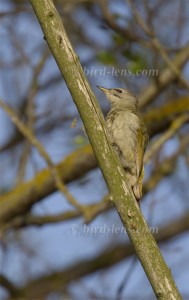 The population of the Gray-faced Woodpecker (Picus canus) in the western Palearctic has declined sharply in the last 20 years. The causes of this are largely unknown, as there are few research results on the birds ecology. While population trends of the Gray-faced Woodpecker in Eastern Europe are stable or even positive in some cases, the species has been experiencing significant population declines in several Central European countries for decades. Possible causes of decline, independent of climate change, can so far only be speculated on, as scientifically based studies are largely lacking. Of the existing studies that have focused on the Gray-faced Woodpecker, only a few contain findings on ecology and population biology.
The population of the Gray-faced Woodpecker (Picus canus) in the western Palearctic has declined sharply in the last 20 years. The causes of this are largely unknown, as there are few research results on the birds ecology. While population trends of the Gray-faced Woodpecker in Eastern Europe are stable or even positive in some cases, the species has been experiencing significant population declines in several Central European countries for decades. Possible causes of decline, independent of climate change, can so far only be speculated on, as scientifically based studies are largely lacking. Of the existing studies that have focused on the Gray-faced Woodpecker, only a few contain findings on ecology and population biology.
It is clear that the Gray-faced Woodpecker inhabits richly structured landscapes with a high proportion of boundary lines between deciduous forests and semi-open cultivated landscapes with orchards, parks, etc.. The Gray-faced Woodpecker inhabits structurally rich, extensive floodplain, oak and beech forests. Marginal patchy forest stands with cavity trees, a high proportion of deadwood and generally a rich vertical structure are particularly favorable. The species feeds mainly on ants, but is not as specialized in this food as the Green Woodpecker (Picus viridis) and can be found foraging more than the latter also on trees. Young succession stages are visited with pleasure, because in them ground-dwelling ants are more frequent than in dense forest stands.
Conditions are favorable in southwest-exposed mixed beech forests, with low ground vegetation with light penetration. This favors the availability and accessibility of ants in summer. Smooth-barked trees provide opportunities for cavity building, and dead wood ensures foraging in winter.
On the one hand, the Gray-faced Woodpecker uses large old trees, although it is unclear whether single trees or several trees together in old-growth stands are preferred. On the other hand, it needs clear areas such as early successional stages or extensively used open land. The use of old trees and clear areas has to do with its breeding biology and likely feeding ecology. The Gray-faced Woodpecker generally builds its breeding cavities in tree species with smooth bark. In Central and Eastern Europe, these are primarily beech trees with an average breast height diameter of over 50 cm. It would be interesting to investigate whether smooth-barked trees are preferred over coarse-barked trees or whether smooth-barked trees are chosen out of necessity because there are too few suitable coarse-barked trees. Smooth-barked trees, as opposed to coarse-barked trees, could minimize the risk of Pine Marten (Martes martes) raiding the breeding burrows. However, at least for its winter food, the Gray-faced Woodpecker depends on coarse barked trees as well as standing dead wood, as it finds tree-dwelling ants and other insects and spiders there during the snowy and frosty months. During the snow-free months, the Gray-faced Woodpecker preys almost exclusively on ground-dwelling ants, which in turn require open, dry, and warm sites. It is unclear how important lying deadwood is for the Gray-faced Woodpecker at least in summer.
Information on the composition of the forest stands used to implement successful species promotion measures is still lacking. Furthermore, there is a lack of information on the required number of cavity trees per ha or the required cubic meters of deadwood per ha. Finally, studies on small-scale habitat use are not sufficient to evaluate which structures the Gray-faced Woodpecker prefers to use. Also the much discussed reason that competition with the Green Woodpecker is responsible for the decline of the Gray-faced Woodpecker in Central Europe is not sufficiently scientifically substantiated so far.
The Gray-faced Woodpecker seems to have a more varied diet than the Green Woodpecker. Of course, it prefers mainly ants (Myrmica, Lasius), both eggs and larvae and adults, which often make up more than 90% of the stomach contents.
But it does not disdain other insects (e.g., Coleoptera larvae) and spiders. Fruit (e.g., those of apples, pears, and cherries), berries, seeds, nuts, and acorns are also consumed, and nectar is ingested.
In order to satisfy the growing demand for top shots of the rarer bird species of the Palearctic, bird-lens.com has made targeted trips to the most beautiful natural landscapes of Brandenburg or Berlin but also to distant places. All this in order to be able to take excellent photos of the birds of the Western Palearctic. The yield of pictures also of rare Western Palearctic birds is very good. The nice picture you see in the blog is just a first impression, what you will find in behind the tab “Picture Shop” very soon. Just let bird-lens.com know if you need the picture of a bird species before new pictures are online.